The business world is a battlefield; you fall behind if you don’t move forward and learn how to stay competitive. History is littered with giants who once dominated their industries but failed to evolve.
Remember Nokia? They snubbed Android and disappeared from the mobile scene. Yahoo? They waved away Google and got lost in the dust. Kodak? They refused to embrace digital cameras, and their empire crumbled. The lesson here? If you’re wondering how to stay competitive in a rapidly shifting world, you must embrace three golden rules: take chances, embrace change, and never become outdated.
1. Take Chances: The Risky Road to Growth
“Fortune favors the bold.” This age-old adage rings especially true in business. Taking risks isn’t about jumping unquestioningly into the unknown; it’s about making calculated moves that propel you forward. Without risk, there is no reward, and without bold decisions, stagnation is inevitable.
Successful entrepreneurs understand that playing it safe rarely leads to breakthroughs. Risk-taking promotes growth, opens new doors, and creates opportunities that wouldn’t exist otherwise. Those who dare to step beyond their comfort zones often find themselves at the forefront of innovation and success.
a. New Opportunities Knock on Risk-Takers’ Doors
Every great success story starts with a leap of faith. Without risk, growth stays stuck in neutral. Risk opens doors to new opportunities, markets, and customers. Time and again, it’s the bold moves—sometimes reckless, often nerve-wracking—that set real momentum in motion. Entrepreneurs who dare to step out of their comfort zones often stumble upon unexpected breakthroughs. Take Amazon, for example: had Jeff Bezos not expanded beyond books, the company wouldn’t be today’s e-commerce giant.
b. Valuable Experiences: Lessons You Can’t Learn Any Other Way
Playing it safe won’t teach you how to handle the heat when things go south. Taking risks forces entrepreneurs to make high-pressure decisions, adapt quickly, and learn from failures. Think of it as a “trial by fire.” The more challenges you tackle, the sharper your instincts become.
c. Innovation: Breaking the Mold
“If you always do what you’ve always done, you’ll always get what you’ve always got.” Playing it safe stifles creativity. Taking risks encourages innovation, and innovation keeps businesses fresh. Apple’s decision to eliminate the headphone jack seemed risky, but it ultimately pushed the industry toward wireless technology. Risk-takers don’t just follow trends—they set them.
d. Financial Success: No Risk, No Riches
Smart risks lead to smart rewards. Investors are drawn to businesses that take calculated risks, solve problems uniquely, and challenge the status quo. Those who diversify investments and seize bold opportunities reap the greatest financial gains. Playing it safe may keep you afloat, but it won’t make waves in the industry.

2. Embrace Change: The Secret Way to Stay Competitive
“Change is the only constant.” Yet, so many businesses resist it, clinging to outdated models until it’s too late. Adaptability is the secret weapon of long-term success and is the best answer to staying competitive.
Those who evolve with the times stay ahead of the curve. Because the market is ever-changing, those who fail to innovate risk being left behind. Therefore, companies that embrace change seize new opportunities, refine their strategies, and remain competitive. Flexibility and a willingness to pivot often separate thriving businesses from those that fade into obscurity.
a. Change Shows How to Stay Competitive and Grow
Refusing to change is like refusing to grow. Industries shift, technologies advance, and consumer behaviors evolve. Businesses that proactively adapt rather than react stay relevant. Netflix pivoted from DVDs to streaming, while Blockbuster stubbornly clung to its rental stores.
The result? Netflix dominates; Blockbuster is history. Ultimately, the key to longevity in any industry is the ability to anticipate shifts and embrace innovation. In turn, companies that welcome change can tap into new markets, enhance efficiency, and create long-term success.
b. The ADKAR Model: A Blueprint for Change
Successful change doesn’t happen overnight. Businesses must navigate transitions strategically to ensure long-term success. The ADKAR model, developed by Prosci, provides a structured approach to change management, helping organizations move smoothly through the process. ADKAR stands for Awareness, Desire, Knowledge, Ability, and Reinforcement.
- Awareness: The first and most critical step is recognizing the need for change. Without awareness, teams may resist or misunderstand the necessity of evolving.
- Desire: Once awareness is established, promoting a genuine willingness to change ensures employees and stakeholders willingly embrace the shift. Resistance often stems from uncertainty, but highlighting benefits can inspire motivation.
- Knowledge: Understanding the “how” behind the transition is crucial. Training, education, and clear communication equip individuals with the tools and insights to implement change effectively.
- Ability: Acquiring the right skills ensures successful execution. Knowledge alone isn’t enough—practical application and hands-on experience make transformation achievable.
- Reinforcement: Keeping the momentum going prevents regression. Regular monitoring, feedback, and positive reinforcement help sustain change over the long term.
Companies that mastered this approach learned how to stay competitive, thrive, and remain ahead of the curve. Those who resist change, however, risk becoming obsolete, much like once-dominant businesses that failed to adapt to market shifts.
Here’s the reality—negotiation is just a conversation. The worst that can happen is you hear “no.” And last time we checked, no one ever got arrested for asking for a better deal. The most successful negotiators are the ones who aren’t afraid to make bold requests and hold firm on their value.

3. Stay Updated: Keep Up or Be Left Behind
The world doesn’t slow down for anyone. Keeping up with industry trends is like reading the map on a fast-moving train. It helps you navigate the landscape, anticipate turns, and stay on track. Businesses that fail to adapt in a rapidly evolving market risk falling behind more informed and agile competitors.
Staying updated allows companies to recognize emerging opportunities, avoid potential pitfalls, and make well-informed decisions. Continuous learning and market awareness are essential for long-term success, ensuring businesses remain relevant and prepared for tomorrow’s challenges.
a. Informed Decision-Making: Knowledge Is Power
Leaders who stay ahead of trends make smarter, more proactive decisions. By tracking industry shifts, they avoid costly missteps and capitalize on emerging opportunities before the competition does. Think of it as reading the playbook before the game begins—those who understand the rules and strategies can anticipate moves and respond effectively.
Access to real-time data, market analysis, and consumer insights allows leaders to make calculated choices that drive growth, minimize risk, and position their businesses for long-term success in an ever-evolving marketplace.
b. Staying Informed Is Crucial to Learn How to Stay Competitive
Leaders who stay informed don’t just follow trends; they create them. Companies that anticipate change rather than respond to it shape the future. Tesla’s focus on electric vehicles wasn’t just a lucky guess—it was a calculated move based on industry foresight.
Forward-thinking businesses invest in research, analyze market patterns, and embrace emerging technologies to stay ahead. By proactively innovating, they set new standards, disrupt industries, and maintain a competitive edge, ensuring they remain relevant in an ever-evolving business landscape.
c. Credibility: Stay Sharp, Stay Respected
Customers, investors, and employees trust leaders who know their industry inside and out. Being well-versed in current trends enhances credibility and positions a business as an industry authority. Nobody wants to follow someone stuck in the past and not knowing how to stay competitive. Staying informed demonstrates expertise, confidence, and a commitment to growth.
Leaders who continuously expand their knowledge inspire trust, attract top talent, and foster strong business relationships. Maintaining credibility through industry awareness ensures long-term success and positions a company as a forward-thinking leader in a world where reputation is everything.
d. Continuous Learning: Adaptability Is a Skill
A great leader is a lifelong student. Learning never stops, especially in a world where technology and consumer demands evolve at lightning speed. Constantly honing your skills and learning new ones is necessary for professionals to remain adaptable and ready to tackle new challenges. Continuous learning fosters innovation, improves problem-solving skills, and enhances decision-making abilities.
Leaders who embrace lifelong education gain a competitive advantage as they can anticipate shifts and adjust strategies accordingly. In an ever-changing business landscape, the willingness to learn and adapt separates thriving professionals from those who struggle to keep up.

e. Effective Communication: Speak the Language of the Industry
Clear, informed communication is crucial in any business. Leaders who stay updated can effectively convey insights, trends, and strategies to their teams. This promotes collaboration and keeps everyone aligned toward a shared vision. Effective communication ensures employees understand industry changes, company goals, and market expectations. It builds trust, encourages open dialogue, and strengthens relationships with stakeholders.
Leaders who articulate their knowledge clearly and confidently create a culture of transparency and shared purpose, ensuring their organization remains agile and competitive in a fast-evolving business environment.
f. Networking and Collaboration: Strength in Numbers
Being well-versed in industry trends opens doors to networking opportunities. Collaboration often leads to strategic partnerships, innovative solutions, and new business ventures. No one thrives in isolation; success is usually built through strong connections. Engaging with peers, attending industry events, and participating in discussions allow professionals to exchange ideas and gain valuable insights.
Strong networks provide access to mentorship, resources, and potential investors. Businesses that actively cultivate relationships within their industry can leverage collective expertise, stay ahead of emerging trends, and create opportunities that drive long-term growth and competitive advantage.
Final Thoughts on How to Stay Competitive
If history has taught us anything, it is that no company is too big to fail. Nokia, Yahoo, and Kodak learned this the hard way. The secret to staying competitive is to take risks, embrace change, and stay informed. The business world isn’t kind to those who stand still, so keep moving, keep evolving, and never let yourself become outdated. Because in the race for relevance, the finish line is always moving.

